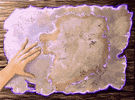Captain Rays Log Day 7: Takes three weeks of steady wind to become a natural course
The ocean doesn't reshape its floor in a single tide. Remember this as you adjust your inner compass toward new horizons. Maritime wisdom teaches that it takes roughly three weeks of consistent sailing for a crew to fully adapt to a new vessel's rhythms and quirks. This isn't to say you won't feel the shift in your sails before then. You will, particularly when you trim them daily toward your chosen star. Begin with one constellation, one true bearing. Each sunset, visualize your ship anchored in that distant harbor you've marked on your chart. Many navigators find it simpler to watch other vessels and imagine how those captains might benefit from these navigation principles. Resist this drift. Chart your own waters first. Set sail on this voyage without doubting whether the winds will find you. Let the journey unfold naturally, like the tide that needs no permission to rise. A new chart in your mind's eye is like dropping anchor in unexplored waters. Mark the spot, study the currents, then trust the ocean's ancient rhythms to guide you. You'll discover that the same forces that carry every vessel across the seas will carry you toward your chosen port. Your steady breath may carry you truer than any tempest.
0
0

Captain Rays Log Day 6: Set Sail & Stop Drifting!
A ship cannot maintain its vitality if it perpetually delays departure, waiting for perfect conditions that may never come. Most captains who postpone setting sail lose precious momentum and fuel. Yet there exists a different kind of pause - dropping anchor to study the charts while your navigation systems recalibrate. This isn't truly delaying your voyage; you're engaging the deeper currents of maritime wisdom. When you understand these hidden tides, you won't condemn yourself for reading the weather, knowing that optimal routes often reveal themselves during these strategic harboring periods. Studying the stars, mending the rigging, testing the depths, and catching favorable winds - these might appear as idle harbor activities to landlubbers. But seasoned mariners recognize a different truth. They see you're honoring the ancient rhythms of seafaring, allowing your internal compass to align with true north. Purposeless anchoring depletes your provisions and morale, while strategic harboring replenishes your capacity to navigate challenging waters ahead. I've been discovering something in these long months at sea that's shifting how I understand this work. Those times when I step away from the charts and navigation - I used to carry such weight about it, as though I was abandoning my duties or running from the helm. But I'm beginning to see it differently now. Sometimes when I'm just sanding the old teak rails, feeling the grain beneath my fingers, or watching the horizon while mending a worn line - that's when the way forward reveals itself. It's as if some deeper current within needed that stillness to find its bearing. I can't claim to fully grasp this mystery, but I'm learning to trust it. Perhaps those moments aren't taking energy away from my soul, but rather conjuring it up from depths I didn't know existed. The sea has her own wisdom about when to push forward and when to drift. I write this for myself, and for any captain who might one day read these pages and wonder if their need for stillness makes them less worthy of command. It doesn't. Maybe it makes us more so.
0
0

Captain Rays Log Day 5: Navigating Your Own Waters
"Chart your course by your own compass." The mystery of how releasing others' charts frees our own compass remains foggy, yet I feel its pull. There's an ancient maritime principle that seasoned navigators understand: you cannot sail another vessel's voyage. Each ship cuts through different waters, faces unique storms, and carries cargo known only to its crew. When we fix our spyglass on distant sails rather than our own horizon, we lose sight of the very stars that guide our journey. The ocean teaches us that watching another ship's wake tells us nothing of their ballast, their provisions, or the storms they've weathered below deck. To measure our voyage by their position is to navigate by mirages on the water. "The shallow waters and the deep seas are but different depths of the same ocean. The wisdom lies in knowing that depth itself is an illusion. The truth of your voyage is this: You sail neither in the shallows nor the depths—you simply sail." —From the Weathered Charts of an Old Mariner The Navigator's Truth: The compass bearing from these waters is clear: your only true competition is with the captain you were at yesterday's dawn. You are a singular vessel, crafted by the Master Shipwright with a hull unlike any other. Rather than scanning the horizon for other ships' positions, set your sextant on a destination that calls to your soul's true north. Be the captain who competes only with yesterday's navigation. Sail beyond your previous best bearing. Each sunrise offers new waters to explore, not to prove your worth against other vessels, but to discover what lies beyond your own last charted territory. Your ship's log should record not how you compared to the fleet, but how far you've sailed from your own last port. The only wake that matters is the one you're creating now, surpassing the course you plotted yesterday. Today's Navigation Practice: Before the sun reaches its zenith, take a moment at the helm. Close your eyes and feel your ship beneath you—not as it compares to others in the harbor, but as the unique vessel it is. Set one coordinate that moves you beyond yesterday's position. Chart it not by another's compass, but by the magnetic pull of your own inner lodestone.
0
0

Captain Rays Log Day 4: Casting Off the Anchors of False Charts
"The sailor who navigates by outdated charts will forever miss favorable harbors." Years spent following charts inherited from old salts who warned against uncharted passages. Their cautions became my gospel, their limitations my prison. Yet watching starlight reflect off calm waters tonight, I recognized how these borrowed bearings have kept me circling the same treacherous shoals. The teaching speaks of recalibrating our inner compass. While splicing new ratlines this afternoon, choosing each knot with deliberate care rather than rushed habit, I felt something shift in my navigation. Perhaps these mental charts we carry aren't carved in stone but sketched in sand, awaiting the tide of our choosing. The mystery of how new coordinates manifest safer passages eludes me still, yet I sense its truth in steadier hands. Every mariner carries invisible cargo—beliefs about the seas we sail, the vessels we command, and most critically, our own capabilities at the helm. These mental charts were drawn long before we learned to read the stars, sketched by those who sailed before us during storms we barely remember. As young deckhands, we absorbed the warnings and wisdom of seasoned crews, accepting their navigational rules as absolute truth. Yet here lies the danger: some of these charts lead to treacherous waters. When the compass of our inner beliefs points us toward rocks instead of open seas, we must have the courage to recalibrate. The mind's navigation system responds faithfully to whatever coordinates we program—steering us either toward prosperous ports or into endless doldrums. Charting New Waters As this voyage into fresh waters begins, examine the old maps you've been following. Select one belief about your seamanship that feels like a weight dragging beneath your hull. Challenge these weathered assumptions: "Who drew this chart? Were their instruments true? What if I simply plotted a new course and trusted my own compass?" Begin with a simple morning ritual—perhaps adjusting your sails with deliberate joy rather than routine obligation. Though the task seems small as a barnacle, envision yourself performing it with the enthusiasm of spotting land after months at sea. Notice how the winds shift in your favor when you navigate from this new bearing.
0
0

Captain Rays Log Day 3: The Navigator's Mind
Your consciousness operates like a ship's navigation system. Though you are not merely a vessel, when you properly set your mental compass, profound shifts occur within your inner waters, much like a well-calibrated instrument finding true north. The transformation you seek doesn't come from forcing the wheel, but from adjusting your internal charts. As ancient mariners knew, when the storm clouds of doubt clash with the clear skies of vision, vision always guides you home. Picture yourself crossing a narrow gangway in calm seas—simple enough. But raise that same plank to the height of a crow's nest, and your mind conjures images of tumbling into the depths below, freezing you in place. This reveals why your internal compass is your most powerful navigational tool. When you set it toward favorable winds, it carries you forward. When you fix it on treacherous waters, it steers you into the storm. I've been navigating by storms rather than stars. The teaching speaks of gangways and crow's nests, yet I recognize this truth in my bones. When tarring deck seams yesterday, mind fixed on peaceful waters ahead rather than gales behind, my hands moved with unfamiliar steadiness. Three minutes each dawn, they say, seeing myself already moored in chosen harbors. I'm only beginning to understand this strange alchemy—how imagined destinations somehow tune the rigging of reality. The mystery persists, yet something shifts when I cease forcing the tiller and instead adjust these charts within. > "The same inner compass that guides you through fog can lead you to your destined port, if you first chart the waters you wish to sail. Before any captain can navigate new seas, they must envision the horizon they seek to reach." —_Captain's Log: Navigating the Inner Seas_ To captains wrestling similar doubts about pausing to envision calmer seas: perhaps this inner plotting isn't retreat but preparation for truer sailing. **Daily Practice:** Each morning, spend three minutes visualizing your ideal destination. See yourself already anchored in that harbor, feeling the satisfaction of arrival. Your subconscious crew will begin adjusting the sails accordingly.
0
0

1-8 of 8


